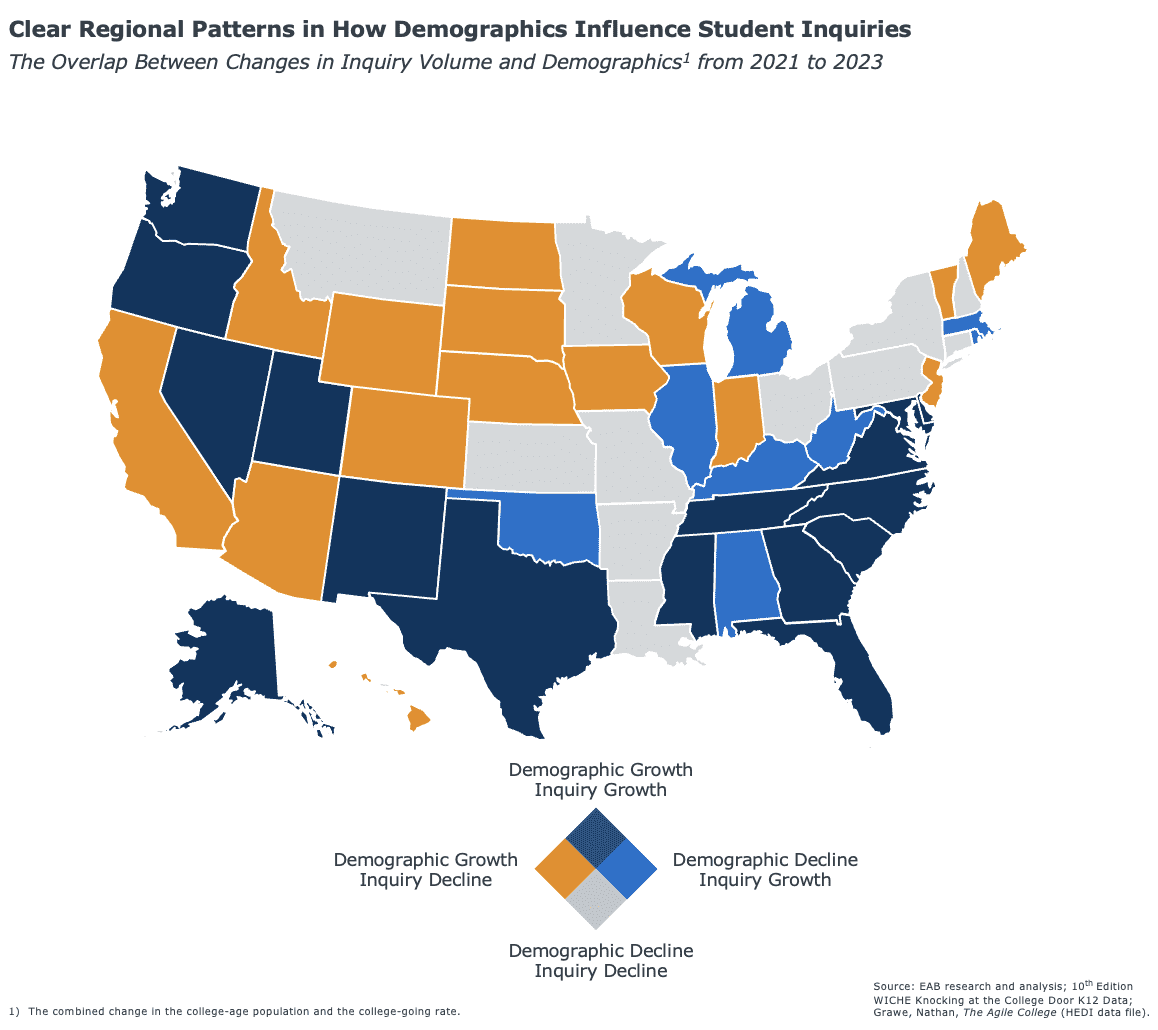How do demographic shifts intersect with college search trends in your region?
Time lags in the major student recruitment data sources (e.g., IPEDS) make it hard to get an up-to-date read on what’s happening in the enrollment market. It can feel like you’re perpetually adjusting your strategy based on information that’s already out of date.
EAB’s proprietary audience data sources—from Enroll360 Audiences—offer a unique opportunity to break through that barrier by providing insight into student search behaviors in something close to real time. This post highlights an example of one category of such data, student inquiry trends, by exploring how demographic shifts intersect with college search trends in your region.
A glimpse into current shifts in student recruitment and demographics
I’ll illustrate these trends with the bivariate map below, which sorts states into categories depending on whether the number of inquiries schools received across each state grew or declined since 2021 and whether the prospective student population in the state grew or declined. For reference, “inquiries” here are instances where students expressed interest in an institution on our platform.
As was demonstrated in our recent insight paper, College Search Trends Across Space and Time, the increases and decreases we’re talking about here aren’t trivial. From 2021 to 2023, they ranged from a 4.7% decline in the prospective student population across the Midwest to a 3.1% increase across the Southwest, and from a 6.9% decline in student inquiries across the West to a 6.7% increase in the Southeast. Data in the analysis is current as of August 2023.
Changes in the prospective student population from 2021 to 2023
-
4.7%
decline in the prospective student population across the Midwest.
-
3.1%
increase in the prospective student population across the Southwest.
Changes in the number of inquiries schools received from 2021 to 2023
-
6.9%
decline in student inquiries across the West.
-
6.7%
increase in student inquiries in the Southeast.

One compelling discovery in this analysis is the emergence of states highlighted in light blue, which experienced an increase in inquiry volume even as their prospective college student populations declined. This outcome underscores that inquiries are influenced by factors beyond demographics, such as a state’s labor market. Equally significant is the active role that demand-generation recruitment marketing campaigns executed by colleges can play in stimulating student inquiries—a point supported by previous research at EAB and elsewhere. This message carries particular weight for colleges in the numerous states highlighted in orange, where institutions failed to boost inquiries despite favorable demographic growth.
Demographics matter, but they’re not the whole story in student recruitment
While these data show that 54% of states exhibited a correspondence between changes in prospective student populations and inquiry volumes, they also reveal that the changes in population do not straightforwardly or deterministically impact the volume of student interest. The interplay between these is more dynamic, mediated by other local factors like economics and active strategies employed by colleges. Several regions exemplify the different forms this dynamic relationship can take:
1. Success in the Southeast: The Southeastern region is emerging as a model for successfully capitalizing on population growth. As corollary analyses demonstrated in the related insight paper, many institutions here (particularly public ones) have excelled in retaining the interest of prospective students within their home state and region. Furthermore, they’ve succeeded in attracting students from other areas. Their strategies could serve as a useful example for institutions in regions where demographic challenges or heightened competition are prominent (such as those in gray or orange states).
2. Challenges in the Northeast: The Northeast presents a contrasting picture as several states in the region are already experiencing the effects of demographic decline. The early onset of the demographic cliff makes it crucial for institutions there to adapt. Institutions across some states (i.e., MA and RI) have managed to counteract these demographic forces and draw in more student interest during the college search, showcasing that it is indeed possible. However, others (i.e., in NJ, VT, ME) are losing ground despite population growth, signaling the need for institutions to better appeal to their primary markets in this challenging context.
3. The Complex Interplay in the Midwest and West: In the Midwest and West regions, there’s a mix of patterns in how demographics and inquiries interact. Of note is the bloc of states in parts of the Midwest and West (in orange) where institutions are losing out on student interest despite population growth. This poses questions about the reasons behind these trends. Is it related to certain “education deserts” in that region where students are seeking higher education elsewhere, or are there other factors at play? These trends contrast with the successes in the south, where institutions are attracting both a growing local population and prospects from other parts of the country. Understanding these complexities is vital for institutions in the Midwest and West to refine their strategies.
Demographics shape market dynamics, but active strategies can drive success
The overarching implication is the need for contextualized and active enrollment strategies. While demographics are a significant factor, institutions must not rely solely on them to drive or predict middle-of-the-funnel engagement with prospective students. They must develop strategies for engaging students that account for local dynamics, including market competition and shifting student preferences. Successful institutions will be those that can adapt to their specific regional conditions—the challenges and opportunities—and employ active strategies that foster meaningful engagement with prospective students.

More Blogs

What enrollment leaders can learn from Alabama’s statewide direct admissions program

Is your yield rate okay?
